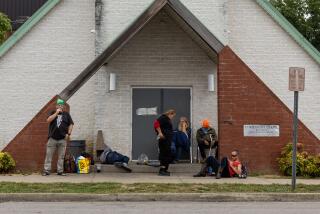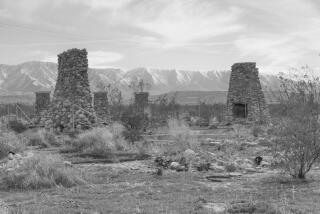Born in Depression, Self-Sufficient Community Outlives Skeptics : Lifestyles: Ridiculed as a social planner’s pipe dream, Arthurdale paid off for forlorn souls who kept the faith of their champion, Eleanor Roosevelt.
- Share via
ARTHURDALE, W.Va. — Where others see failure, Glenna Williams looks out her living room window onto rolling farmland that gave hope to several dozen struggling coal miners’ families 60 years ago.
Congress saw little success there, but Williams, 75, sees dreams that were pushed ahead by the grand New Deal experiment of Arthurdale and poor miners’ children who became doctors, lawyers and teachers.
“Their dreams were not really fulfilled,” she said. “But those of us who lived here, we feel good about what’s happened. We feel very successful.”
Arthurdale was the first of nearly 100 planned rural communities created by President Franklin D. Roosevelt’s Administration in 1933 to help ease the impact of the Great Depression.
The idea was of a self-sustaining community of farms, food and factories where people depended on one another, shielded from the ravaged economy outside.
“It was part of the social experimentation of the day, kind of a back-to-the-land movement,” said Arthur Schlesinger Jr., a Pulitzer Prize-winning historian who has written several books on Roosevelt’s Administration.
“Our dream was different from the dreams they had,” said Williams, a retired schoolteacher. “We wanted a place where a family could live without being afraid of being thrown out, where they could raise a garden and have something.”
Planning and financial setbacks, and dwindling political support, caused the federal government to pull out in 1947, but Arthurdale’s 165 original homes still stand, many occupied by children and grandchildren of Depression homesteaders.
“It brought new life to 165 families and that proceeded through to other generations,” said Marilee Hall, who publishes a newsletter about the town.
“In our community, we have doctors and lawyers produced from these poor coal mining families that didn’t even have enough food to eat.
“It gave them a new lease on life. The government might have said they were wasting money, but look at the citizens they got out of it. That’s America,” she said.
In 1933, First Lady Eleanor Roosevelt visited nearby Morgantown, about 75 miles south of Pittsburgh, and saw the poverty and despair of coal miners fighting for unionization and against the economic conditions of the time.
“Many people . . . worked no more than two or three days a week. Some of the children were subnormal, and I often wondered how any of them grew up,” Eleanor Roosevelt wrote in her autobiography.
Within months, 1,000 acres once owned by Col. John Fairfax, an aide to George Washington during the Revolutionary War, were purchased for $35,000. Unemployed workers began work immediately, clearing land and building roads.
Plans called for 200 three- and four-bedroom homes to be built by settlers on 2 1/2 acres to 5 acres. The settlers would work either in a community factory or on cooperatives. Plans also included a health clinic, dairy, filling station, grocery store and post office.
But Arthurdale received swift criticism, particularly from Congress and the media, and it had problems of its own.
The first 50 houses, ordered sight unseen, were poorly insulated summer cottages, and foundations did not fit the prefabricated structures.
In August, 1934, the Saturday Evening Post featured a story on the construction problems, complete with photos of brick chimneys and fireplaces eight feet from the outside walls of the houses.
Congress also quickly rejected plans for a community furniture factory to supply the U.S. Post Office.
“They didn’t want the government going into competition with private industry and they turned it down flat,” Williams said.
Other businesses, including shirt and vacuum cleaner factories, also failed because of high costs and inefficiency.
An average homesteader plot included an acre of wheat, several types of fruit trees, a grape arbor and forage crops for livestock. Officials had hoped residents could grow all they needed and sell the excess.
In the end, most residents turned to work outside the community.
Still, people had a place to call their own and found a pride that rarely existed in the mining camps. Children who previously received just an elementary education went to high school and college.
“The chance is real good I wouldn’t have gotten to go to high school,” said Maynard Weaver, 67, the town’s postmaster for 27 years.
Weaver said Arthurdale offered hope and life.
“The community was real close-knit,” he said. “There were lots of community activities because that’s all the people had. The people didn’t get in a car and go somewhere else. Most of them didn’t even own a car. All your recreation, everything, was right here.”
For Williams and her family, the future looked as bleak as their coal camp before they joined the first group of people to move to Arthurdale in June, 1934.
A three-room home whose cracks allowed snow to blow through was replaced by a four-bedroom frame house with electricity, indoor plumbing and a bathroom. Rent, based on what a family could afford, was about $20 a month.
“No one ever went hungry after they came to Arthurdale if they were willing to work,” Williams said. “It wasn’t a promised land flowing with milk and honey unless you made it flow milk and honey. It took your own efforts.”
Residents also were taught about weaving, pottery and pewter. The handcrafted items, rarely affordable to the residents, were sold in upscale New York shops.
Many of Arthurdale’s residents had never seen a doctor or dentist, but they could go to a clinic subsidized by the government and a monthly association fee. Physicals, immunizations and prenatal care became standard.
Arthurdale also was a first step toward public housing.
“Now we accept federal housing as an integral part of government,” said Stephen Haid, former state education secretary who wrote a doctoral thesis on Arthurdale. “It was a new departure in 1933. It was controversial. It was labeled socialistic.”
But, by 1937, failures pulled down successes and the government stopped building homes. A $25-million revolving fund established for the communities failed, and the government began selling the houses to residents in the early 1940s.
“Did it become a model that could be applied universally? No, it didn’t,” Haid said. “But it sure taught a lot of valuable lessons, and I think it adequately demonstrated that people respond to opportunity.”
Beulah Myers, 86, still lives in the house she and her then-unemployed husband moved into sight unseen in 1935 from a Preston County mining camp. Her old house was “just a two-bedroom shanty.”
“It was just one of those old mining houses. We didn’t have running water. We thought we were in heaven when we moved in over here,” she said.
She reared 11 children and often entertained Eleanor Roosevelt on her frequent visits. A metal sign out front proudly proclaims her as an original homesteader.
“She (Eleanor Roosevelt) was our champion. She was the one who fought for us through thick or thin,” Williams said.
Today, much of the land has been subdivided, and the community has swelled to more than 1,000 people. Aluminum siding, additions and garages have been added, and satellite dishes now sit in back yards.
Even the federal government recently became involved in the community again, earmarking $500,000 for renovation efforts this year.
Williams said it is important that the community survive as an example of what determination and hard work can accomplish.
When she hears stories about the homeless and the unemployed, she can point out her front window.
“For the most of us, people were just delighted with the chance to get here and go to work and have a new beginning,” she said.
“We had a chance to start over, and I think that’s what lots of people need today--a chance to start over and some direction.”
More to Read
Sign up for Essential California
The most important California stories and recommendations in your inbox every morning.
You may occasionally receive promotional content from the Los Angeles Times.









